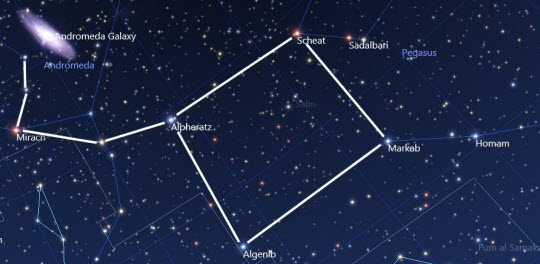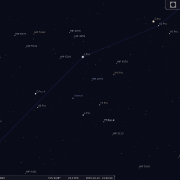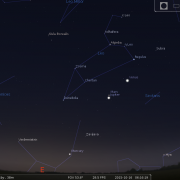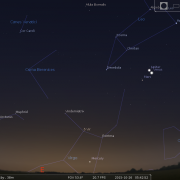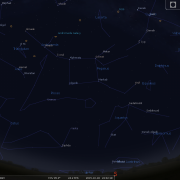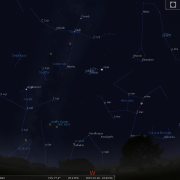Welcome to the WDAS monthly newsletter for October 2015: a digest of the month's latest contributions to our website. Below you'll find Society News, Sky Notes and In-Focus articles printed in full. There's also future events, and trailers for other articles which appear in full on the website - just a click away!
On the website you'll also be able to comment on articles, and if you'd like to play an editorial role in creating new content, just let us know!
Quick Summary for October:
- WDAS Monthly Meetings restart on Tuesday 6th October
- Special Star Parties at Fylinghall School on October 2nd, Westerdale Village Hall on October 9th, and Danby Moors Visitors Centre on October 31st
Society News
Second Hooks House Farm Event
The second star party held at Hook’s House was every bit as fortuitous as the first, with all the grotty weather endured during the day, scooting off into the north sea just in time for party goers to enjoy crystal clear skies. Admittedly it was a little chilly for the time of year, but the curry and rice, poppadoms, sausage rolls and crostinis all helped to warm members and public alike. Indeed it was a veritable feast!
Because the weather had been so autumnal earlier, it was pleasing that so many campers came out to view the dark skies at such short notice. To start, Saturn was on show for longer than we dare hope for, but the deep sky objects looked fantastic, noticeably better than normal, much to the astonishment of those queuing to look through the eyepieces. An excellent evening all round. Thanks to Warren and Andi for the banquet, Keith and Lee for scope assistance and the Halder’s for the use of the campsite. Let’s hope next year is every bit as good.
West Cliff Events
Making up for the poorer conditions earlier in the summer, our late summer West Cliff star party schedule, bar one event, was largely unhindered by the weather, a real bonus! Indeed the final two star parties on the 25/26th greatly benefited from clear skies and healthy public interest. Moonlight did somewhat hamper deep sky viewing, but those objects we did observe provoked the desired reactions.
 The final event on the 26th was sponsored by Wrestles dot dogs, apparently one had to be eaten before each new object was targeted a satisfying way to round off our ‘culinary’ summer observing season.
The final event on the 26th was sponsored by Wrestles dot dogs, apparently one had to be eaten before each new object was targeted a satisfying way to round off our ‘culinary’ summer observing season.
Westerdale Visit
Our good fortune continued for the annual pilgrimage over to Westerdale, as conditions for the event on Sept 19th were very much to our liking, clear and relatively mild. For once the navigation held up, with no one going astray on route, and we all arrived in good time to set the scopes up. Indeed plan B never made it out of the car.
Our colleague John Randles was on hand to greet us at the village hall car park and was in fine form. Quite a gathering turned up and once Mark had ‘sorted’ the nuisance security flood lights, the venue was plunged into darkness and observing could begin.
Saturn and a waxing crescent moon were first up, before setting in the SW and despite the low altitude both looked remarkably clear. Numerous deep sky objects were then targeted, all tied in with Mark’s laser pointer presentation of the night sky. With a sky tour supplied by Mark and quiche supplied by Warren; a most enjoyable way to spent a few hours was the general consensus of opinion.
 Fylinghall School Event: Oct 2nd
Fylinghall School Event: Oct 2nd
We have been invited to host a star party at Fylinghall School on Friday October 2nd for a 19:00h start. If conditions are cloudy, an indoor, presentation and scale solar system demonstration will be given. Anyone wishing to assist, please contact Mark.
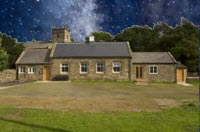 School’s Event in Westerdale: Oct 9th
School’s Event in Westerdale: Oct 9th
We have been invited to host a star party / presentation for a special needs school class, with the likely venue being Westerdale Village Hall on Friday Oct 9th from 19:00h. However matters are not as yet set in stone and may alter. Further details will be given at the October meeting and also placed on the website.
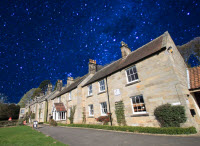 Danby Moors Centre Event: Oct 31st
Danby Moors Centre Event: Oct 31st
Yet another foray up the Esk valley, this time to the Danby Visitor Centre on Saturday October 31st. The event has been organised by Emma Mckenzie, assistant events and volunteer’s coordinator for the North Yorkshire Moors Parks authority. Apparently Grover Optics will also be in attendance, as well as other attractions which will run throughout the day. Our slot is from 17:30-19:30pm. More details will be given at the October meeting and also placed on the website, or contact Mark. A further visit is already planned for February of next year. Details will be posted in the New Year.
Event Details
This event is organised by North York Moors National Park, marking the end of British summer time with children’s crafts, dark forest walks, lantern-making, track identifying, shadow fun and stargazing activities. Hot soup and drinks are available, and don’t forget a torch!
Disclaimer: stary nights may differ from those pictured and are supplied for illustrative purposes only.
In-Focus
The Square
 One of the chief constellations of the autumn night sky is the group of Pegasus. The main body of this constellation, known as the ‘Square of Pegasus’ can be utilised as a ‘signpost’ for locating constellations and leading stars arranged in the south and eastern aspects of the sky.
One of the chief constellations of the autumn night sky is the group of Pegasus. The main body of this constellation, known as the ‘Square of Pegasus’ can be utilised as a ‘signpost’ for locating constellations and leading stars arranged in the south and eastern aspects of the sky.
By following a line diagonally through Alpheratz and Markab (alpha Pegasi) down to the South-East, you are first guided to a zig-zag arrangement of stars representing the water jar, part of the zodiac constellation of Aquarius, the Water Bearer. Continue on this same trajectory to locate Capricornus- the Sea Goat, just above the SSW horizon. By projecting a line down through Markab from Scheat to the SSE horizon, you will drop onto Fomalhaut the most southerly of first magnitude stars (those ranked brightest) visible from Britain. Fomalhaut marks the mouth of Pisces Austrinus- the Southern Fish, the constellation’s northern counterpart; Pisces, occupies a large portion of the sky below Pegasus. A faint circlet of stars directly below the square represent Aphrodite the western fish, whilst the eastern fish; Heros swim below Andromeda. A ribbon of faint stars joins the two.
We now turn from small fry, to the largest sea creature in the heavens; Cetus, the Whale. This constellation may be hunted down by using Alpheratz and Algenib as pointers. Its brightest star, Deneb Kaitos or Diphda, marks the great tail of the creature. Alpha Ceti or Menkar denotes the beasts head, below the stars of Aries. The most celebrated object in Cetus is a variable star called Mira “the wonderful”, an extraordinary pulsating red super giant perhaps 200 million miles in diameter. At maximum, Mira is visible to the naked eye, but requires binoculars or a small scope when at minimum seven months later. Mira lies roughly midway between Menkar and Diphda. See if you can spot it in binoculars.
The ‘square’ asterism also serves as the jumping off point for tracking down our ‘nearby big sister galaxy’, the Andromeda galaxy, see below.
The Andromeda Galaxy
 With moonlight absent during the evenings from the second week in October, why not try to seek out an entirely separate galaxy with just the naked eye. Sound difficult? Well it’s easier than you may think. First find the great Square of Pegasus located a couple of hand spans above the east horizon. Extending eastwards away from Alpheratz, the square’s upper left hand star, a chain of stars mark the main body of Princess Andromeda. Starting from Alpheratz, count two stars along this chain before turning northwards passing two fainter stars. Close by the second of these look for an elongated misty patch of light; the Andromeda Galaxy.
With moonlight absent during the evenings from the second week in October, why not try to seek out an entirely separate galaxy with just the naked eye. Sound difficult? Well it’s easier than you may think. First find the great Square of Pegasus located a couple of hand spans above the east horizon. Extending eastwards away from Alpheratz, the square’s upper left hand star, a chain of stars mark the main body of Princess Andromeda. Starting from Alpheratz, count two stars along this chain before turning northwards passing two fainter stars. Close by the second of these look for an elongated misty patch of light; the Andromeda Galaxy.
At a distance of 2.65 million light years our sister galaxy is considered the most remote object visible to the unaided eye. If skies are dark and transparent it should be relatively easy to identify, but if you are not sure use the “averted vision” technique; i.e. don’t look directly at the object, but to one side, utilizing the more sensitive rod cells of the eye allowing faint nebulous objects to stand out.
The Andromeda galaxy, together with our own Milky Way and another spiral galaxy, the Pinwheel galaxy ( marked on chart - M33) are the three ‘big fish’ in a cluster of galaxies known as the ‘local group’ all gravitationally bound together. The others are small irregular galaxies too faint for the average backyard telescope. In an expanding universe where everything is hurtling away from one another, the Milky Way and the Andromeda galaxy are slowly edging together, a process that will take four to five billion years, merging around the time our Sun reaches the end of its life. So, whether you use the naked eye, binoculars or a telescope to view our ‘near’ galactic neighbour, it is astonishing to reflect that this faint smudge of light emanates from over 300 billion suns arranged in a spiral system spanning some 160,000 light years across. The combined radiance diminished only by a 2.65 million year journey, a journey that started when our early human ancestors first gazed up at the starry firmament.
Sky Notes
In this month's Sky Notes:
Planetary Skylights
 Saturn continues to linger in evening twilight sky very low the SW, but by mid month it is just about lost in glare.
Saturn continues to linger in evening twilight sky very low the SW, but by mid month it is just about lost in glare.

 Uranus and Neptune as the only 'evening planets' visible, but a telescope is required to reveal their tiny disks. Uranus comes to opposition on the 12th residing in Pisces below eta Piscis (see chart) and will be due south at midnight. Neptune resides in Aquarius between the two naked eye stars of sigma and lambda Aquarii.
Uranus and Neptune as the only 'evening planets' visible, but a telescope is required to reveal their tiny disks. Uranus comes to opposition on the 12th residing in Pisces below eta Piscis (see chart) and will be due south at midnight. Neptune resides in Aquarius between the two naked eye stars of sigma and lambda Aquarii.



 All the planetary action is to be found in the early morning sky, where Venus, Mars, Jupiter and Mercury all reside. View to the east at 06:00h between the 8-11th when the waning crescent moon slides by all the planets. Brilliant Venus is uppermost, then Mars, followed by conspicuous Jupiter and finally, just above the horizon, Mercury. Mars and Jupiter are closest on the 17 & 18th with Jupiter and Venus closest on the 26th, Finally, Mars and Venus are closest on the 31st!
All the planetary action is to be found in the early morning sky, where Venus, Mars, Jupiter and Mercury all reside. View to the east at 06:00h between the 8-11th when the waning crescent moon slides by all the planets. Brilliant Venus is uppermost, then Mars, followed by conspicuous Jupiter and finally, just above the horizon, Mercury. Mars and Jupiter are closest on the 17 & 18th with Jupiter and Venus closest on the 26th, Finally, Mars and Venus are closest on the 31st!
 Mercury has its best morning apparition of the year growing in brightness as October progresses, although it will be slipping back toward the horizon at the same time. The optimum window to observe Mercury will be around mid month when it is at its highest above the horizon, at 10 degrees. Look due East around 06:00h.
Mercury has its best morning apparition of the year growing in brightness as October progresses, although it will be slipping back toward the horizon at the same time. The optimum window to observe Mercury will be around mid month when it is at its highest above the horizon, at 10 degrees. Look due East around 06:00h.
Meteor Activity

The Orionids (Oct 16-27) are the month's most reliable shower, peaking during daylight hours on the 21st, therefore unusually the hours before midnight on the 21st will be best. Hourly rates are in the mid twenties, however actual observed rates will be around 8-10 per hour. Like May’s Eta Aquarids, Orionids are associated with Comet Halley; Orionids are swift, often producing persistent trains. With the moon around quarter phase, prospects look reasonable.
The weak Piscid shower has three peak dates, Oct 13th being the optimum. Observed rates are little better than sporadic levels - around 3-7 per hour. Piscid meteors are often slow, of long duration, but not very brilliant. Perhaps the most interesting shower is the Giacobinids or Draconids (Oct 6-10th peaking on the 9th) which are associated with the periodic comet Giacabini- Zinner (6yrs) The shower is very erratic, but can produce outbursts of activity so keep an eye open. Early morning viewing will be the optimum time
|
Looking South
Mid October - 22:00h |
Looking North |
|
Looking East
Mid October - 22:00h |
Looking West
Mid October - 22:00h |
|
|
|
|
Overview
Mid October - 22:00h |
|
Additional Image Credits:
- Planets and Comets where not otherwise mentioned: NASA
- Sky Charts: Stellarium Software


